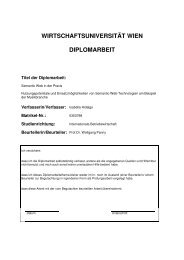Wirtschaftsuniversität Wien Magisterarbeit - SemanticLab
Wirtschaftsuniversität Wien Magisterarbeit - SemanticLab
Wirtschaftsuniversität Wien Magisterarbeit - SemanticLab
Create successful ePaper yourself
Turn your PDF publications into a flip-book with our unique Google optimized e-Paper software.
• Data necessary to identify the type of communication<br />
• Data necessary to identify users communication equipment or what purports to be<br />
their equipment<br />
• Data necessary to identify the location of mobile communication equipment<br />
2.4.2.3. Threats to privacy<br />
Exactly this ability to track and trace every action of users on the Internet poses a threat<br />
to privacy as users are not able to make use of the Internet in an anonymous to access<br />
information way as often proclaimed [Woo06]. This is especially true as ISP nowadays<br />
have to store even more information about their customers as described above [Dow05].<br />
This collected data can technically be used in all kind of ways. For example, when users<br />
visit websites, these visits are normally logged by the webserver which processes the<br />
requests necessary to display the website in the customers’ browser. Every single access<br />
is logged in the logfiles of the webserver including the IP-address 7 of the user [NLC].<br />
Now the IP-address is the piece of information which links the data collected in the<br />
logfiles of the webserver with the data collected of the customers’ ISP. So technically,<br />
every user can be personally identified if connecting these two databases, provided that<br />
this data is logged. With these data retention policies in place, specific users can be<br />
kept under “online surveillance” by government agencies [Dow05].<br />
These issues show the significance of this topic and that (online) privacy will become<br />
an even more important topic in the future.<br />
2.4.3. Online profiling<br />
2.4.3.1. Purpose<br />
Today, “online profiling is the collection of information about Internet surfing behaviour<br />
across many different websites for the purpose of formulating a profile of users habits and<br />
interests” [Wie02], especially in online advertising [Wei07]. Only by collecting user data<br />
and connecting this data, users’ preferences can be understood and hence additional<br />
value can be delivered on a website or other Internet applications [Rub08].<br />
2.4.3.2. Collected data<br />
For online profiling all kind of data is collected. Mainly, there are the following sources<br />
of data: (webserver) logfiles, information collected via input provided on websites and<br />
special applications such as web bugs, cookies or software agents [Wie02]. Both descriptive<br />
data (such as customers’ preferences) and identifying data (such as a customers’<br />
name or address) can be collected. [Ste07] describes an experiment where webserver<br />
7 An IP-address is a unique number on the Internet to uniquely identify a network device such as a<br />
16<br />
computer





